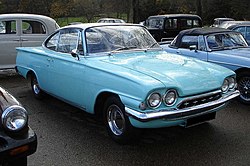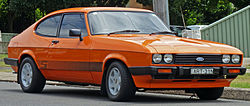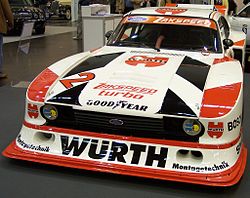Ford Capri
 |
|---|
| Ford Capri was a name used by the Ford Motor Company for three different automobile models. The Ford Consul Capri coupé was produced by Ford of Britain between 1961 and 1964. The Ford Capri coupé was produced by Ford of Europe from 1969 to 1986. The Ford/Mercury Capri convertible was produced by the Ford Motor Company of Australia from 1989 to 1994.
The Capri name was also used by Ford's Lincoln-Mercury Division on six different models which did not bear the Ford name. The Lincoln Cosmopolitan Capri from 1950 to 1951; the Lincoln Capri from 1952 to 1959; the Mercury Comet Capri in 1966–1967; and three different generations of Mercury Capris from 1970 to 1994. |
 |
 |
|---|---|
 |
 |
 |
 |
|---|
| The Capri was a two-door coupé version of the Ford Classic saloon made by Ford of Britain. The Ford Classic was a result of 4 years of development. Approval for the project was given in autumn 1956. The styling of the car was the last project undertaken by Colin Neale before he left Dagenham for Dearborn. The initial design requirement was for the Ford Classic to be a full range model to take Ford into the new decade. Ford even developed a full-size estate (station wagon) prototype.
The Capri Project was code named "Sunbird" and took design elements from the Ford Thunderbird and the Ford Galaxie Sunliner. It was instigated by Sir Horace Denne, Ford's Sales Director. He wanted a "co-respondent's" car to add glamour to the product line. It was designed by Charles Thompson who worked under Neale and had sweeping lines, a large boot space and a pillarless coupé roof. |
 1974 Ford Capri 3.0 GXL |
|
| Manufacturer | Ford of Europe |
|---|---|
| Also called | Mercury Capri |
| Production | 1969-1974 |
| Assembly | Dagenham, Halewood, United Kingdom Genk, Belgium Cologne, Saarlouis, Germany Homebush, Australia |
| Successor | Ford Capri Mk II |
| Class | Mid-size sports car |
| Body style | Fastback coupé |
| Layout | FR layout |
| Engine | petrol: V4 1.3 L, 1.5 L, 1.7 L, 2.0 L (UK) I-4 1.3 L, 1.6 L, 2.0 L, V6 2.0 L, 2.6 L, 3.0 L, 3.1vL, 3.4 L |
| Transmission | 4-speed manual all-synchromesh |
| Wheelbase | 100.8 in (2,560 mm) |
| Length | 168.5 in (4,280 mm) |
| Width | 64.8 in (1,646 mm) |
| Height | 50.7 in (1,288 mm) |
| Curb weight |
2,053 lb (931 kg) 2,522 lb (1,144 kg) 3000GXL |




 |
 |
|---|---|
 |
 |
 |
 1962 Ford Consul Capri |
|
| Manufacturer | Ford of Britain |
|---|---|
| Body style | 2-door coupé |
| Engine | 1340 cc I4 (OHV) 1961 - 1962 1498 cc I4 OHV 1962 - 1964 |
| Wheelbase | 99 in (2,515 mm) |
| Length | 170.75 in (4,337 mm) |
| Width | 65.3 in (1,659 mm) |
| Height | 54 in (1,372 mm) |
| Curb weight | 2,100 lb (953 kg) approx |
| Related | Ford Consul Classic |
 |
|---|
| The first Ford Capri to bear that precise name was introduced in January 1969 at the Brussels Motor Show, with sales starting the following month. The intention was to reproduce in Europe the success Ford had had with the North American Ford Mustang; to produce a European pony car. It was mechanically based on the Cortina and built in Europe at the Dagenham and Halewood plants in the United Kingdom, the Genk plant in Belgium, and the Saarlouis and Cologne plants in Germany. The car was named Colt during development stage, but Ford were unable to use the name, as it was trademarked by Mitsubishi. Although a fastback coupé, Ford wanted the Capri Mk I to be affordable for a broad spectrum of potential buyers. To help achieve that, it was available with a variety of engines. The British and German factories produced different line-ups. The continental model used the Ford Taunus V4 engine in 1.3, 1.5 and 1.7 L engine displacement, while the British versions were powered by the Ford Kent straight-4 in 1.3 and 1.6 L form. |
 1974 Ford Capri Mk II |
|
| Manufacturer | Ford of Europe |
|---|---|
| Also called | Mercury Capri |
| Production | 1974-1978 |
| Assembly | Dagenham, Halewood, United Kingdom Genk, Belgium Saarlouis, Cologne, Germany |
| Predecessor | Ford Capri Mk I |
| Successor | Ford Capri Mk III |
| Class | Mid-size sports car |
| Body style | Hatchback coupé |
| Layout | FR layout |
| Engine | petrol: I-4 1.3 L 1.6 L, 2.0 L, V6 2.3 L, 3.0 L |
| Transmission | Manual transmission |


 Ford Capri III S |
|
| Manufacturer | Ford of Europe |
|---|---|
| Production | 1978-1986 |
| Assembly | Dagenham, Halewood, United Kingdom Genk, Belgium Cologne, Saarlouis, Germany |
| Predecessor | Ford Capri Mk II |
| Class | Mid-size sports car |
| Body style | Hatchback coupé |
| Layout | FR layout |
| Engine | petrol: I-4 1.3 L, 1.6 L, 2.0 L, V6 2.0 L, 2.3 L, 2.8 L, 3.0 L |
| Transmission | Manual transmission, Automatic transmission |
| Wheelbase | 101 in (2,565 mm) |
| Length | 167.8 in (4,262 mm) |
| Width | 67 in (1,702 mm) |
| Height | 51 in (1,295 mm) |
| Curb weight | 2,227 lb (1,010 kg) 1.3L 2,293 lb (1,040 kg) 1.6S 2,273 lb (1,031 kg) 2.0S 2,620 lb (1,188 kg) 2.8i 2,688 lb (1,219 kg) 3.0S |


 |
|---|
| The Capri proved highly successful, with 400,000 cars sold until 1970. Ford revised it in 1972 to become what is known by enthusiasts as the Capri "Bis" (i.e. "second") or, in the UK, the "Mk I facelift" Capri. The car received a new and more comfortable suspension, rectangular headlights, enlarged tail-lights and new seats. The Kent engines were replaced by the Ford Pinto engine and the previously UK-only 3000 GT joined the German lineup. In the UK the 2.0 L V4 remained in use.
In addition, North American versions received larger rubber-covered bumpers (to comply with U.S. DOT regulations) for 1973. 1973, saw the highest sales total the Capri ever attained, at 233,000 vehicles: the 1,000,000th Capri, an RS 2600, was completed on 29 August. In December, Ford replaced the Cologne V6 based RS2600 with the Essex V6 based RS3100, with the usual 3.0 L Essex V6's displacement increased to 3098 cc. Unlike its predecessor, it used a double-barrel Weber carburettor, and reached the same 150 PS (110 kW). Only 250 RS3100s were built for homologation purposes. |
 |
|
|---|---|
 |
 |
 |
 |
| In February 1974, the Capri II was introduced. After 1.2 million cars sold, and with the 1973 oil crisis, Ford chose to make the new car more suited to everyday driving with a shorter bonnet, larger cabin and the adoption of a hatchback rear door. By the standards of the day, the Capri II was a very well evolved vehicle with very few reliability issues. For Germany the Capri now offered 1.3-litre (55 PS (40 kW)), 1.6-litre (72 PS (53 kW)) or 2.0-litre (88 PS (65 kW)) in-line four-cylinder engines, complemented by a 2.3-litre (108 PS (79 kW)) and the UK sourced 3.0-litre V6. |
|---|
 |
|
|||||||||||||||||||||||||||||||||||
|---|---|---|---|---|---|---|---|---|---|---|---|---|---|---|---|---|---|---|---|---|---|---|---|---|---|---|---|---|---|---|---|---|---|---|---|
 |
|||||||||||||||||||||||||||||||||||
 |
|---|
| The Capri Mk III was referred to internally as "Project Carla", and although little more than a substantial update of the Capri II, it was often referred to as the Mk III. The first cars were available in March 1978, but failed to halt a terminal decline in sales. The concept of a heavily facelifted Capri II was shown at the 1976 Geneva show: a Capri II with a front very similar to the Escort RS2000 (with four headlamps and black slatted grille), and with a rear spoiler, essentially previewed the model some time before launch. The Mk III featured improved aerodynamics, leading to improved performance and economy over the Mk II and the trademark quad headlamps were introduced. At launch the existing engine and transmission combinations of the Capri II were carried over, with the 3.0 S model regarded as the most desirable model although, in truth, the softer Ghia derivative with automatic, rather than manual transmission, was the bigger seller of the two V6-engined models. |
 |
 |
|---|---|
 |
 |
 |
 |

 http://en.wikipedia.org/wiki/Ford_Capri http://en.wikipedia.org/wiki/Ford_Capri |
 |
|---|---|
 http://www.fordcapri.co.uk/ http://www.fordcapri.co.uk/ |
 |
 http://www.fordcapri.co.nz/ http://www.fordcapri.co.nz/ |
 |










 HOME;
HOME;






